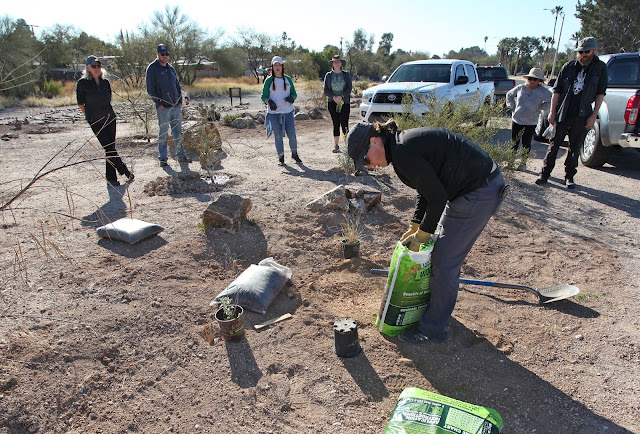Pollinator Garden Takes Wing with Tucson Audubon Support
By Rhonda Bodfield
 |
| Urban Habitat Restoration Manager Kari Hackney leads a planting day at the park |
Not very long ago, a site on a vacant parcel across from Palo Verde Park was a dumping ground for discarded mattresses, tattered couches and piles of construction debris.
But no more.
Now, a new habitat has risen with nearly 60 new native plants that can now entice bees, butterflies and other pollinators.
“The site was just an eyesore,” explained Fred Araiza, a 13-year resident in the Palo Verde Park Neighborhood. “We installed a labyrinth to provide people with an outlet for contemplation and reflection during the pandemic, hoping it would make the site be more welcoming and encourage participation on that segment of the park.”
The neighborhood association had previously partnered with Tucson Clean & Beautiful and the City of Tucson Parks and Recreation to install a water harvesting project on the site.
Even so, it was still too stark. Araiza and other neighbors brainstormed options for the parcel and decided that a pollinator garden would serve two important purposes: Providing key habitat to support pollinators, while also bringing new life that would make the site more appealing to visitors.
“We knew we would need expertise to make this happen. We didn’t know the first thing about what it would take to make a pollinator garden successful,” Araiza said.
Enter the Tucson Audubon Society.
The neighborhood association had seen other examples of Audubon gardens throughout the community, so they reached out for help.
Urban Habitat Restoration Manager Kari Hackney came out to survey the site. The association contracted with her for a design, relying on drought tolerant native plants that will provide a natural habitat for insects to forage and rest. She also made sure to select plants that will bloom at different points in the season, attracting pollinators year-round.
“Getting the design was a first step in ensuring us that this was a viable concept. The participation from the Audubon Society really gave us confidence in asking our neighbors to help us fund the project,” said President Mike Southworth.
Next, the association set up an online donation fund, allowing neighbors to sponsor the 58 plants that would be phase one of the design. Neighbors raised the $700 within two weeks and Desert Survivors helped secure the plants.
The next step was no easier: Preparing the soil. Residents knew exactly what they were getting into: The land was so densely compacted and so riddled with caliche that they’d had to use jackhammers to put in the earlier water harvesting project. Two sessions with a rototiller didn’t make a dent, so the group rented an auger to drill out 58 holes.
About two dozen neighbors, along with the Ward Two Council Office, showed up to help put in the plants. Kari opened the event with a brief planting demonstration and helped plant.
“By letting neighbors sponsor plants, it was a great way to help spread awareness of the importance of native plants and also provided neighbors with a sense of ownership in their park. I think these community efforts are so important on a number of fronts and I'm hoping their experience helps inspire others to make differences in ways that they can.”
While neighbors happily surveyed their work, a hummingbird appeared, surveying its new surroundings as it fed on the nectar of one of the newly-planted penstemons.
A good omen perhaps for a new beginning.
Rhonda Bodfield is on the Neighborhood
Council for Palo Verde Park Neighborhood.

.jpg)
Comments
Post a Comment
Thanks, we value your opinions! Your comment will be reviewed before being published.